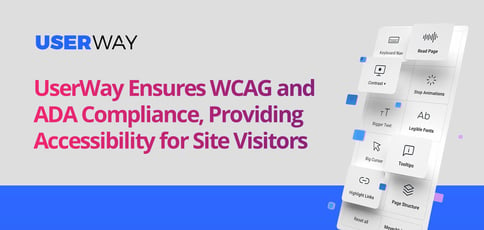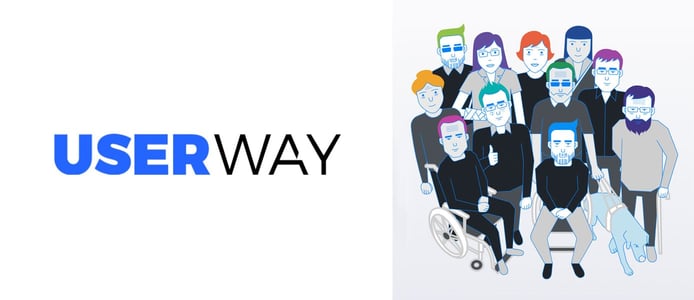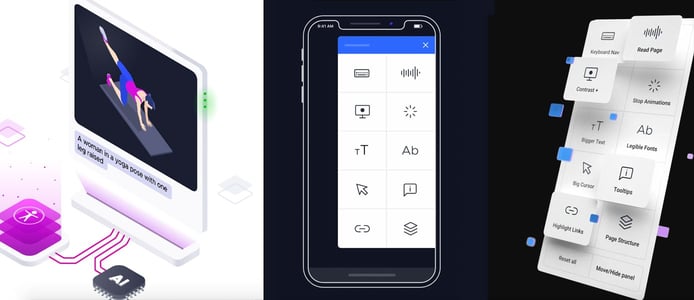
TL; DR: There’s a lot more to building an online presence than finding a reliable host. UserWay’s advanced accessibility tools help businesses and individuals ensure compliance with accessibility regulations and standards without rewriting existing code. The company’s fully automated Compliance as a Service (CaaS) solution measures, monitors, and corrects accessibility violations using a powerful blend of artificial intelligence (AI) and machine learning (ML). Ultimately, UserWay is leveraging decades of accessibility expertise to foster a more inclusive online environment for us all.
Building an online presence from the ground up is no easy task. It involves everything from choosing reliable hosting — the foundation of any site — to strategically insulating its contents from cybercriminals via security tools. One bad decision can mean the difference between a site that’s well-functioning or at risk of collapse.
But to construct a robust website, there’s more to consider than the job site itself. The paths leading to them must also be carefully considered in the form of web accessibility practices.
After all, what’s the point in building a site that can withstand heavy traffic if there’s no way for those with visual, auditory, mobility, cognitive, and intellectual needs to get there?

UserWay makes it possible to ensure compliance with accessibility regulations and standards without rewriting code.
“People don’t realize it, but one-fifth of the population needs some remediation to interact with or access information on the web,” said Lionel Wolberger, Ph.D., VP of Business Development at UserWay. “And that’s a conservative estimate.”
Proper design and development techniques can help remove barriers that prevent interaction with and access to websites. However, significant accessibility issues on the world wide web are still rampant, creating a hostile environment for some users. The science says it all: In a 2016 study by the Pew Research Center, Americans living with disabilities were three times as likely to say they never go online than those without disabilities.
Fortunately, like managed hosting packages, no-hassle solutions exist to help site owners be more inclusive. UserWay, for example, takes the stress out of achieving compliance with Federal ADA and Section 508 accessibility regulations, allowing individuals, businesses, and enterprises to avoid hefty fines and welcome new site visitors.
Using AI and ML to Demystify Online Accessibility
Serial entrepreneur Allon Mason was inspired to start UserWay while building up XPlace, an Israel-based online freelancing marketplace.
“We realized how difficult it was to ensure the site met accessibility standards and decided it would be helpful to share our findings with the world,” Lionel said. “We created our accessibility widget, which many people tried to recreate — but beware of imitators. They often make widgets that achieve a small fraction of what we do.”
Lionel said UserWay has essentially pioneered the digital accessibility space with its compliance-as-a-service (CaaS) solutions, which leverage the power of both artificial intelligence (AI) and machine learning (ML) to deliver accessible digital experiences that exceed governmental regulations.
Today, the fully-automated platform remediates issues in a wide range of areas, including color contrast, keyboard navigation, readability, forms, links, alt attributes, and page structure, among others.
“Accessibility is complicated,” Lionel said. “Our low-hanging fruit, in terms of early accomplishments, was to use AI to provide descriptions for missing alt text. That was easy compared with keyboard navigation, where the focus needs to go in an orderly fashion from left to right and from top to bottom. When you have blocks of activity, these things are almost impossible to do without AI. And that’s where UserWay is leading the pack.”
Meet Standards Designated by the W3C
Lionel considers himself fortunate to serve on the World Wide Web Consortium (W3C), an international organization responsible for the Web Content Accessibility Guidelines (WCAG), a set of standards designed to make the internet more accessible to people with disabilities.
“In my humble opinion, W3C represents one of the most successful and important sets of standards that have ever existed —on the level of standards for electrical power distribution and driver safety,” he said. “They’re so stackable, so flexible, that they’ve become what people think of when they refer to the internet.”
The most current WCAG standards, versions 2.0 and 2.1, are organized using four principles — perceivable, operable, understandable, and robust — which are testable via three levels of success criteria: A, AA, and AAA.
Thus far, Lionel said compliance has been achieved via a carrot-and-stick approach. The carrot, luring businesses to meet standards, comes in the form of a potentially broader user and visitor base. Unfortunately, Lionel said some companies are now using the W3C’s work to exploit unsuspecting victims — and that’s where the stick comes in.

The tools streamline the compliance process via a user-friendly interface.
Opening up your site to all users has real benefits, but many businesses struggle to realize it. Lionel said that’s because people tend to think of disabilities only in terms of vision and auditory impairments.
“Beyond that, there are impairments we consider at UserWay that no one else comes close to including,” he said. “Say there’s a user, Patton, who has post-traumatic stress disorder (PTSD). He finds certain types of violent imagery deeply upsetting. At the W3C, we see a very simple way to tackle these things, similar to what is done on radio and television with words that are considered offensive. In this case, we use HTML markup.”
UserWay refers to this as a personalization workstream, a technology which the company plans to add to its widget. “We are very passionate about bringing features like this to our end users as quickly and smoothly as possible,” he said.
Accessibility Through Simplicity and Elegance of Design
The UserWay team sees accessibility as a three-legged stool made up of manual inspection, real-time monitoring, and remediation.
“If you want to achieve AAA compliance, nothing replaces a manual inspection where users with disabilities check your site using screen readers and other forms of assistive technology,” Lionel said. “Secondly, you need to scan and monitor in real time. For example, you still run antivirus software even though you’re careful not to click on ransomware emails — it’s that last mile.”
Finally, there’s the third leg: a logical, automated remediation layer. While UserWay is deeply committed to automation in its real-time monitoring and remediation functions, the company isn’t relentlessly seeking to automate every aspect of the service proposition.
“We understand there’s a role for manual, and we’re always looking for ways to engage customers in the future in that respect,” Lionel said.
Remove the Complexity of Fast-Changing Regulations
Advancements in technology have made it easier than ever for site creators to get up and running online without any coding or design experience. As our readers know, most hosting companies offer one-click WordPress solutions and free site-builders that make site creation a matter of minutes, rather than days or weeks.
With UserWay, the same can be said for compliance with accessibility regulations and standards.
“Today’s content is quite dynamic; therefore, businesses need dynamic compliance,” Lionel said. “Even the smallest businesses can have two or three people working on a website. If Anne, who writes the blog, doesn’t catch up with Lenny, the expert in accessibility, Lenny will still get an alert if Anne forgot to put in her alt text or created a convoluted navigation path on a new landing page.”
The lesson here? Similar to a managed hosting package or no-code site builder, UserWay’s web accessibility monitoring and remediation take the headaches out of compliance with ever-changing regulations so that businesses can focus on their core competencies.
HostingAdvice.com is a free online resource that offers valuable content and comparison services to users. To keep this resource 100% free, we receive compensation from many of the offers listed on the site. Along with key review factors, this compensation may impact how and where products appear across the site (including, for example, the order in which they appear). HostingAdvice.com does not include the entire universe of available offers. Editorial opinions expressed on the site are strictly our own and are not provided, endorsed, or approved by advertisers.
Our site is committed to publishing independent, accurate content guided by strict editorial guidelines. Before articles and reviews are published on our site, they undergo a thorough review process performed by a team of independent editors and subject-matter experts to ensure the content’s accuracy, timeliness, and impartiality. Our editorial team is separate and independent of our site’s advertisers, and the opinions they express on our site are their own. To read more about our team members and their editorial backgrounds, please visit our site’s About page.

